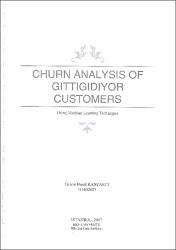Please use this identifier to cite or link to this item:
https://hdl.handle.net/20.500.11779/1163| Title: | Chuen Analysis of Gittigidiyor Customers |
| Other Titles: | Gittigidiyor müşterileri için bağlılık analizi |
| Authors: | Kantarcı, Özlem Hazal |
| Advisors: | Çakar, Tuna |
| Keywords: | Churn Analysis Class Imbalance Problem Feature Selection Pivot Table Correlation Process Time Accuracy Classifier Boosting Linear Dscriminant Analysis Decision Tree Bağlılık Analizi Sınıf Dengesizliği Özellik Seçimi Pivot Tablo Çalışma Süresi Başarı Yüzdesi Korelasyon Sınıflandırıcı Karar Ağacı Doğrusal Diskriminant Analizi |
| Publisher: | MEF Üniversitesi, Fen Bilimleri Enstitüsü |
| Source: | Kantarcı, ÖH. (2017). Chuen analysis of Gittigidiyor customers, MEF Üniversitesi Fen Bilimleri Enstitüsü, İstanbul, Türkiye |
| Abstract: | In this project, it is aimed to estimate the loyalty of the customers of the e-commerce company named GittiGidiyor by analzying the customer movements and examined which movements affected the customer loyalty positively / negtively. In the dataset studied, it was seen that the number of active customers is much higher than that of passive customers. Several methods have been tried to solve this "Class imbalance" problem and it has been decided to replicate some lines of passive customers. Rows of smaller classes are duplicated to compensate classes with generated code. The data set was divided into training, validation and test and different algorithms were used. One of the innovative approaches was training and validating models in an earlier time window and testing the model with samples from a later time window. As a result of the studies, it was decided to use "Linear Discriminant Analysis" considering its short training time and especially the success of predicting passive customers. GittiGidiyor e-ticaret şirketinin müşterileri için bağlılık tahmini yapılması hedeflenen bu projede müşteri hareketlerinin analizi yapılarak müşteri harketlerinden müşteri ağlılığı tahmin edilmeye çalışıldı. Üzerinde çalışılan veri setinde, aktif müşteri sayısının pasif müşterilerden çok daha fazla olduğu görüldü. Bu "Sınıf Dengesizliği" sorununu çözmek için bir çok yöntem denendi ve pasif müşterilerin bazı satırlarının çoğaltılmasına karar verildi. Geliştirilen kod ile sınıfları dengelemek için daha küçük sınıfın satırlarının çoğaltılması sağlandı. Veri seti eğitim, doğrulama ve test olarak üçe ayırarak farklı algoritmalar ile çalışıldı. Uygulanan inovatif yaklaşımlardan birisi eğitim ve doğrulamayı daha önceki bir zaman diliminde yapılan işlemler ile yapılması, testin daha sonraki bir zaman diliminde yapılan işlemler ile yapılması oldu. Çalışmalar sonucunda hem eğitim süresinin kısa olması hem de özellikle pasif müşterileri tahmin etme başarısı göz önünde bulundurularak "Linear Discriminant Analysis" kullanılmaya karar verildi. |
| URI: | https://hdl.handle.net/20.500.11779/1163 |
| Appears in Collections: | FBE, Yüksek Lisans, Proje Koleksiyonu |
Files in This Item:
| File | Description | Size | Format | |
|---|---|---|---|---|
| ÖzlemHazalKantarcı.pdf | YL-Proje Dosyası | 12.57 MB | Adobe PDF |  View/Open |
CORE Recommender
Sorry the service is unavailable at the moment. Please try again later.
Items in GCRIS Repository are protected by copyright, with all rights reserved, unless otherwise indicated.